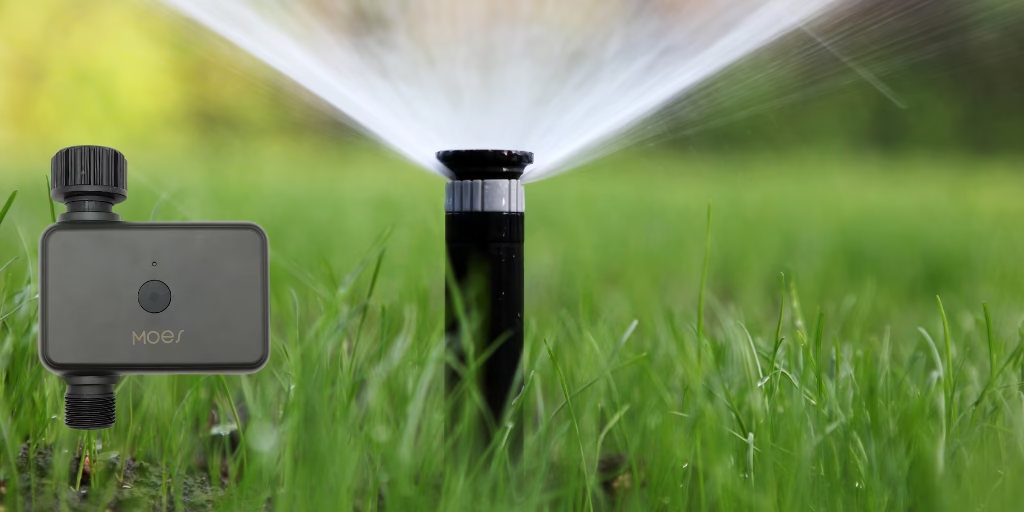Smart Irrigation Systems and Smart Water Timers
Smart irrigation systems and water timers are devices designed to automate and optimise watering schedules for gardens, lawns, and outdoor spaces. These systems can adjust watering based on real-time data such as weather conditions, soil moisture levels, and plant types.
They connect to smartphones or home automation platforms, enabling remote control and insights. Many models integrate with voice assistants like Alexa or Google Assistant for convenience.
How To Connect A Smart Water Timer To a Water Supply
The vast majority of garden smart water timers simply connect to an external tap (usually 3 /4 inch thread), in much the same way a hose pipe does. A hose or irrigation pipe then connects to the other end of the smart water timer. Some timers have a single outlet, while others have multiple outlets.
Having a timer with multiple outlets allows for watering ‘Zones’ to be created. Which simply means multiple hose pipes \ irrigation systems can be attached, watering different areas (zones) of the garden.
Wireless Technologies Used by Smart Water Timers
Smart water timers rely on various wireless technologies for connectivity and control. Each has its own advantages, making it suitable for different needs:
Bluetooth: Ideal for small-scale gardens or close-range use, Bluetooth-enabled water timers connect directly to smartphones or tablets. They offer simplicity and don’t require a hub, but their range is typically limited to around 10-30 metres.
Wi-Fi: Wi-Fi-based timers are widely popular, providing broader connectivity through your home network. They allow remote control and scheduling from anywhere with internet access. However, they require a stable Wi-Fi signal and consume more power than other wireless technologies.
Zigbee: Zigbee is a low-power, wireless mesh protocol designed for smart home integration. It requires a hub but offers excellent range and scalability, making it perfect for larger gardens with multiple zones.
LoRa (Long Range): LoRa technology excels in vast outdoor spaces like farms or large properties. It has an impressive range of several kilometres, is highly power-efficient, and works well in areas with limited internet connectivity.
Z-Wave: Similar to Zigbee, Z-Wave is a low-power mesh network that requires a hub. It’s highly reliable for smart home setups and offers strong interoperability with other smart devices.
When choosing a smart water timer, consider your garden’s size, connectivity needs, and whether it will integrate with existing smart home platforms. Let me know if you’d like help exploring specific options!
Controlling the Water Timer – Manually, Remotely or Automatically
The water timer can then be controlled either manually (not so smart) using a button or switch physically located on the water timer, remotely using an app or an automation can be configured. Automations can be simple schedules or more advanced using soil moisture sensors to trigger the timer when the soil reaches a low level
Benefits of Smart Irrigation Systems and Water Timers
These devices provide numerous advantages:
- Water Conservation: Avoid waste by watering only when necessary, reducing environmental impact and costs.
- Convenience: Automate watering schedules and manage them remotely from your smartphone.
- Healthier Plants: Ensure plants receive the ideal amount of water for optimal growth and health.
- Cost Savings: Lower utility bills by optimising water usage.
- Customisation: Tailor watering schedules to different garden zones based on plant types and soil conditions.
- Integration: Many systems integrate seamlessly with smart home platforms for unified control.
- Usage: Some smart irrigation devices can show how much water has been used
Features to Look for When Buying
Consider these features when choosing a system:
- Zone Control: Manage multiple zones independently for varied watering needs.
- Weather Adaptation: Systems that adjust watering schedules based on weather data save water and improve efficiency.
- Mobile App Integration: User-friendly apps offer remote control, Automation and real-time updates.
- Voice Assistant Compatibility: Look for systems that work with Alexa, Google Assistant, or Apple HomeKit.
- Ease of Installation: Most domestic smart water timers are very easy to install and use
- Power: Most domestic smart irrigation devices are battery powered, but some require mains power and some are mains powered with a battery backup
Types of Garden Taps
Garden taps come in standard sizes, which are critical for connecting accessories like hoses and smart water timers. The most common sizes are:
1/2 Inch BSP (British Standard Pipe):
A standard size for older garden taps and those in smaller outdoor setups.
3/4 Inch BSP:
The most common size for modern garden taps.
1 Inch BSP:
Less common but used in larger-scale applications, such as commercial landscaping or agricultural settings.
Most garden taps follow the BSP (British Standard Pipe) threading system in the UK, ensuring compatibility with standard hoses and timers. Always check the size of your tap’s outlet before purchasing accessories.
Conclusion
Smart irrigation systems and water timers offer a modern, efficient way to manage water usage. From conserving resources to promoting healthier plants, these devices are ideal for gardeners and landscaping enthusiasts alike.
Evaluate your needs, garden size, and desired features to choose the best system. Investing in smart irrigation technology is a step towards sustainable and convenient outdoor living.





